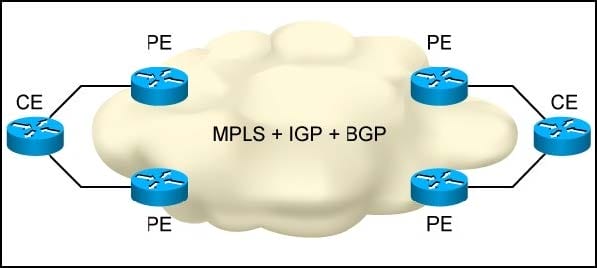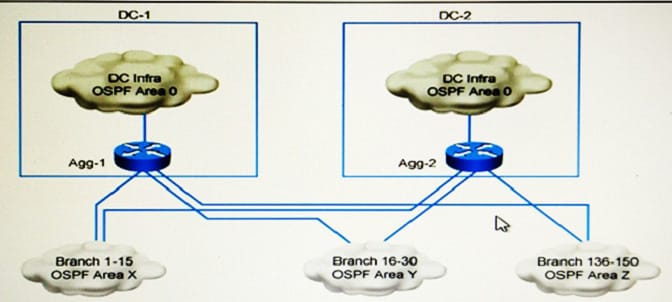352-001 Online Practice Questions and Answers
FIFO queuing is being used on all routers in a network. The primary application running on the network is data backup using FTP. At certain times, users experience cyclical performance degradation.
What two things might mitigate this problem and help ensure bandwidth is used effectively in the network? (Choose two.)
A. traffic shaping
B. CB-WFQ
C. traffic policing
D. WRED
E. MDRR
How are community formats sent in SNMPv1 and SNMPv2c?
A. In both protocols they are encrypted.
B. In both protocols they are sent as clear text.
C. In SNMPv1 they are sent as clear text and in SNMPv2c they are encrypted.
D. In SNMPv1 they are sent as clear text and in SNMPv2c they are sent as part of an encrypted session.
When creating a design plan for IPv6 integration, you decide to use stateless encapsulation of IPv6 packets into IPv4 tunnels between subscriber CPEs and a border relay. Which deployment technique allows for this functionality?
A. 6rd
B. Dual-Stack Lite
C. 4rd
D. DSTM
When network summaries are created for access networks in a network design, how does it change the behavior of the Shortest Path First (SPF) running in a backbone area?
A. There would be fewer incremental SPFs.
B. There would be fewer partial SPFs.
C. There would be fewer full SPFs.
D. There would be no change with the SPFs.
Refer to the exhibit.

Which configuration change would maximize the efficiency of both the routing design and data forwarding plane in this topology?
A. configure Router B to advertise the more specific prefixes instead of the aggregate
B. configure Router B to advertise the more specific prefixes in addition to the aggregate
C. configure Router B with a static route for the aggregate to Null0
D. configure Router A to advertise 10.0.0.0/8 instead of the default route to Router B
Which VPN technology supports multivendor interoperability on a network design?
A. VTI
B. DMVPN
C. Easy VPN
D. IPsec VPN
Refer to the exhibit.

You are designing an MPLS network with Layer 3 VPNs, where the traffic path must be the same in both directions inside the MPLS network to ensure that symmetric routing occurs. The sites are connected to two PE routers. Which two design considerations will allow you to achieve this symmetric routing? (Choose two.)
A. When MPLS TE is used, the bidirectional TE tunnel automatically provides symmetric routing.
B. The MPLE TE tunnels should be set up in both directions so that the same path is used.
C. There should not be any equal cost paths for IGP inside the MPLS backbone, the IGP routing should use the same path in both directions, and the BGP routing does not matter.
D. There should not be any equal cost paths for BGP inside the MPLS backbone, the BGP routing should use the same path in both directions, and the IGP routing does not matter.
E. There should not be any equal cost paths for the IGP and the BGP inside the MPLS backbone, and both IGP and BGP routing should use the same path in both directions.
When designing a network that consists of multiple IPv6 multicast servers on a Layer 2 VLAN, which option should you consider regarding IPv6 multicast traffic forwarding?
A. The RP IP address is embedded in IPv6 multicast address.
B. IPv6 multicast addresses are assigned based on network prefix.
C. IPv6 multicast addresses are assigned by IANA.
D. IPv6 multicast flooding optimization requires Layer 2 switches support of MLD snooping.
Which two components are the responsibility of the customers in a Platform as a Service offering? (Choose 2)
A. data
B. APIs
C. hardware
D. applications
E. infrastructure connectivity
A healthcare customer requested that health statistics from their infrastructure devices are to be sent over their service provider MPLS network. Which protocol must be enabled?
A. SNMPv3
B. Syslog TLS
C. syslog
D. SNMPv2
E. SSH
A regional ISP is running MPLS TE. These tunnels are configured manually using paths.
Which technology centralizes the traffic engineering decisions to reduce operational complexity?
A. BGP Link State
B. DiffServ-TE
C. TE autobandwidth
D. Shared Risk link Group
Which two options are IoT use cases that require the low-latency and high reliability that 5G networks provide? (Choose two)
A. Sports and Fitness
B. Smart Home
C. Automotive
D. Smart Cities
E. Industrial Automation
F. Health and wellness
A Company has these requirements for access to their wireless and wired corporate LANs using 802.1x Clients devices that corporate assets and have joined the active directory domain are allowed access Personal devices must be not allowed access Clients and access servers must be mutually authenticated. Which solution meets these requirements?
A. Protected EAP/Microsoft CHAP v2 with user authentication
B. EAP-TLS with machine authentication
C. EAP-TLS with user authentication
D. Protected EAP/Microsoft CHAP v2 with Machine authentication
Refer to the exhibit,

company xyz has 150 branch location across the U.S. Each branch is connected to two aggregation router one router in each data center The network is configured with Multiple OSPF with multiple OSPF areas and the aggregation router are ABRs A requirement is to keep an optimal path to the data centers and at the same time reduce the LSA propagation and SPF recomputation during a change in any part of the network
Which design elements should be included on the aggregation router?
A. OSPF NSSA
B. distribute lists
C. OSPF summarization
D. OSPF totally stubby area
Refer to the exhibit. ACME Mining has four data centers in Santiago, Cape Town, Mumbai, and Beijing. They are full-mesh connected via a 400 Mb/s EVP-LAN. A 1-TB file transfer occurs daily via FTP between the Santiago and Mumbai data
centers. When testing, this data transfer took an "unexpected and outrageous" 6 hours, with an average transfer rate of 47 KB/s. The network team provided this information:
LAN bandwidth usage was below 5% at both data centers during transfer.
WAN bandwidth usage was between 20-30% at both data centers during transfer.
The only QoS on WAN is 200 Kb/s strict priority configured for other types of traffic.
There is no QoS on LAN.
The ping RTT average between data centers is 378 milliseconds.

Which action improves the file transfer rate?
A. Classify the FTP transfer and use the strict priority queue on the WAN
B. Use TFTP instead of FTP
C. Apply WAN optimization techniques at both data centers
D. Use SFTP instead of FTP
